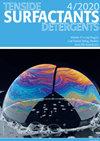新型紫外敏感阴离子-阳离子三聚体表面活性剂/反式-邻甲氧基肉桂酸胶束体系流变学研究
IF 1.2
4区 工程技术
Q4 CHEMISTRY, APPLIED
引用次数: 0
摘要
采用两种碳链长度不同的三聚阴离子-阳离子表面活性剂(TACS,包括TDCC和TCCC)和光敏添加剂反式-邻甲氧基肉桂酸(trans-OMCA),成功合成了三聚十二烷基阴离子-阳离子表面活性剂(TDCC)/反式omca和三聚十六烷基阴离子-阳离子表面活性剂(TCCC)/反式omca两种新型紫外光敏胶束体系。trans-OMCA的加入使体系的零剪切粘度(η 0)在pH = 6.17-6.61时达到峰值。carau - yasuda模型很好地描述了TACS/OMCA体系的流动特性。在紫外线照射之前,TCCC/trans-OMCA体系表现出明显的剪切变薄、触变和粘弹性。在365 nm紫外线照射后,反式omca异构化为顺式omca,导致网络结构破坏,导致触变性和粘弹性显著降低,导致粘度降低。TCCC/trans-OMCA体系的降粘率达到99%。研究了疏水碳链长度对紫外响应性的影响。紫外辐照后,TDCC/trans-OMCA体系的η值降低了86%,表明较长的疏水尾链对提高胶束体系的紫外响应性有良好的作用。研究了TCCC/trans-OMCA溶液的紫外光动力学,建立了准确描述粘度变化的流变学模型。发现TCCC在pH = 6.17 ~ 6.61时主要表现为阳离子特征。在此pH范围内,2 wt% TCCC/0.12 wt% NaSal体系表现出优异的粘弹性,而trans-OMCA的加入破坏了网络结构,导致粘度降低。经UV照射后,体系的粘度提高了2.5倍,证实了TCCC/NaSal/trans-OMCA胶束体系作为UV增稠剂的潜力。本文章由计算机程序翻译,如有差异,请以英文原文为准。
Study on rheology of a novel UV-light sensitive trimeric anionic–cationic surfactant/trans-o-methoxycinnamic acid micellar system
Two novel UV photosensitive micellar systems, trimeric dodecyl anionic–cationic surfactant (TDCC)/trans -OMCA, and trimeric cetyl anionic–cationic surfactant (TCCC)/trans -OMCA, were successfully synthesized by using two different carbon chain length trimeric anionic–cationic surfactants (TACS, including TDCC and TCCC) and the photosensitive additive trans -o-methoxycinnamic acid (trans -OMCA). The incorporation of trans -OMCA resulted in a peak in the zero shear viscosity (η 0 ) of the system at pH = 6.17–6.61. The flow behaviour of the TACS/OMCA system was well described by the Carreau-Yasuda model. Prior to UV irradiation, the TCCC/trans -OMCA system exhibited pronounced shear thinning, thixotropic, and viscoelastic properties. After UV irradiation at 365 nm, the isomerization of trans -OMCA to cis -OMCA caused the disruption of the network structures, leading to a significant decrease in the thixotropic and viscoelastic properties, resulting in a decrease in viscosity. The viscosity reduction rate of the TCCC/trans -OMCA system reached 99 %. The influence of the hydrophobic carbon chain length on the UV responsiveness was also investigated. The TDCC/trans -OMCA system exhibited an 86 % decrease in η 0 after UV irradiation, highlighting the favorable effect of longer hydrophobic tail chains in improving the UV responsiveness of the micellar system. The UV light kinetics of the TCCC/trans -OMCA solution were studied and a rheological model was developed to accurately describe the viscosity changes. The TCCC was found to predominantly exhibit cationic characteristics at pH = 6.17–6.61. In this pH range, the 2 wt% TCCC/0.12 wt% NaSal system exhibited excellent viscoelasticity, and the addition of trans -OMCA disrupted the network structure resulting in a decrease in viscosity. After UV irradiation, the viscosity of the system increased by 2.5 times, confirming the potential of the TCCC/NaSal/trans -OMCA micellar system as a UV thickener.
求助全文
通过发布文献求助,成功后即可免费获取论文全文。
去求助
来源期刊

Tenside Surfactants Detergents
工程技术-工程:化工
CiteScore
1.90
自引率
10.00%
发文量
57
审稿时长
3.8 months
期刊介绍:
Tenside Surfactants Detergents offers the most recent results of research and development in all fields of surfactant chemistry, such as: synthesis, analysis, physicochemical properties, new types of surfactants, progress in production processes, application-related problems and environmental behavior. Since 1964 Tenside Surfactants Detergents offers strictly peer-reviewed, high-quality articles by renowned specialists around the world.
 求助内容:
求助内容: 应助结果提醒方式:
应助结果提醒方式:


